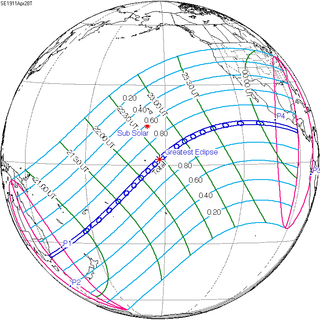| Solar eclipse of April 28, 1911 | |
|---|---|
| Type of eclipse | |
| Nature | Total |
| Gamma | −0.2294 |
| Magnitude | 1.0562 |
| Maximum eclipse | |
| Duration | 297 s (4 min 57 s) |
| Coordinates | 1°54′N 151°54′W / 1.9°N 151.9°W |
| Max. width of band | 190 km (120 mi) |
| Times (UTC) | |
| Greatest eclipse | 22:27:22 |
| References | |
| Saros | 127 (52 of 82) |
| Catalog # (SE5000) | 9306 |
A total solar eclipse occurred at the Moon's ascending node of orbit between Friday, April 28 and Saturday, April 29, 1911,[1][2][3][4] with a magnitude of 1.0562. A solar eclipse occurs when the Moon passes between Earth and the Sun, thereby totally or partly obscuring the image of the Sun for a viewer on Earth. A total solar eclipse occurs when the Moon's apparent diameter is larger than the Sun's, blocking all direct sunlight, turning day into darkness. Totality occurs in a narrow path across Earth's surface, with the partial solar eclipse visible over a surrounding region thousands of kilometres wide. Occurring about 1.4 days before perigee (on April 30, 1911, at 9:00 UTC), the Moon's apparent diameter was larger.[5]
Totality was visible from southeastern tip of Australia, Tonga, American Samoa and the Cook Islands. A partial eclipse was visible for parts of Oceania, southern North America, Central America, and the western Caribbean.
- ^ "April 28–29, 1911 Total Solar Eclipse". timeanddate. Retrieved 31 July 2024.
- ^ "SOLAR ECLIPSE TODAY WILL BE ADVANTAGE TO SCIENCE". Billings Evening Journal. Billings, Montana. 1911-04-28. p. 3. Retrieved 2023-11-03 – via Newspapers.com.
- ^ "The eclipse to be seen". The Southern Star. Bega, New South Wales, Australia. 1911-04-29. p. 2. Retrieved 2023-11-03 – via Newspapers.com.
- ^ "TO-DAY'S SOLAR ECLIPSE". The Sun. Sydney, New South Wales, Australia. 1911-04-29. p. 1. Retrieved 2023-11-03 – via Newspapers.com.
- ^ "Moon Distances for London, United Kingdom, England". timeanddate. Retrieved 31 July 2024.
